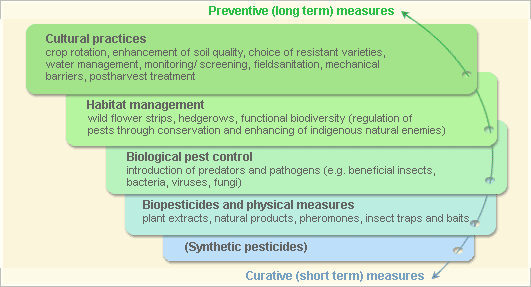Geographical Distribution in Africa
Geographical Distribution of the Turnip Mosaic Virus in Africa (red marked). Updated on 10 July 2019. Source CABI
General Information on Disease and Damage
Damage
Infected plants are stunted, with leaves coarsely mottled and distorted. Black spots develop on leaves which prematurely drop. Early infection of cabbage by this virus in the seedbed or soon after transplanting, can reduce yield by 75%, whereas late-season infection has little or no effect on yield. It also reduces seed yield.
Host range
Turnip mosaic virus (TuMV) has a very wide host range infecting at least 318 species in 156 genera of 43 families. TuMV infects most cruciferous plants, but is most damaging in Chinese cabbage, turnip, mustard, and radish. It also attacks beets, spinach and tobacco.
Symptoms
On cabbage: Mosaic, black speckling or stippling of cabbage heads at harvest or during storage can be caused by the TuMV or the cauliflower mosaic virus occurring singly or together. The latter causes lumpy or warty growths on the veins on the under surface of leaves and vein clearing. In stored cabbage, black sunken spots develop on leaves throughout the head. The spots are considerably larger than those caused by cauliflower mosaic virus. Its mode of transmission is similar to TuMV (i.e. aphids and mechanically). However, cauliflower mosaic virus has a restricted host range. It is infectious only to members of the cabbage family (brassicas).
Affected plant stages
Flowering stage, fruiting stage, seedling stage and vegetative growing stage.
Affected plant parts
Leaves, seeds, stems and whole plant.
Symptoms by affected plant part
Leaves: lesions; abnormal colours; abnormal patterns; abnormal forms; yellowed or dead.
Seeds: empty grains; lesions.
Stems: external discolouration; abnormal growth; dieback.
Whole plant: plant dead; dieback; dwarfing; early senescence.
Biology and Ecology of the Turnip Mosaic Virus
Transmission
TuMV is transmitted by aphids notably green peach aphid (Myzus pericae) and cabbage aphid (Brevicoryne brassicae) and is readily transmitted mechanically. The virus is transmitted by aphids in a non-persistent manner (short virus transmission period of 10 to 30 seconds) with no latent period (the time from start of an acquisition feeding until the vector can infect healthy plants with the virus). It can be acquired in less than one minute and can be inoculated in less than a minute. The transfer of viruses by aphids usually occurs over short distances (up to a few hundred metres), particularly down-wind and involves migrating alates (winged aphids). Weather conditions and temperature influence aphid activity and migration patterns which in turn affect dissemination of TuMV. Dry and warm conditions favour aphid reproduction and dissemination and hence early and increased spread of the virus. Cool, wet and windy conditions reduce the reproduction and movement of aphids and hence spread of the virus.
Once primary infections are established in fields, TuMV may spread relatively rapidly from plant to plant if aphids are not controlled. Seed transmission of the virus has not been observed.
Sources of Infection
Primary sources of TuMV infection are diseased host plants and weeds. Vectors can be introduced into field crops with infected transplants. Transplantscan become infected during propagation in nursery beds. It is not seed transmitted.
Pest and Disease Management
Pest and disease management: General illustration of the concept of Infonet-biovision

This illustration shows the methods promoted on infonet-biovision. The methods shown at the top have a long-term effect, while methods shown at the bottom have a short-term effect. In organic farming systems, methods with a long-term effect are the basis of crop production and should be of preference. On the other hand methods with a short-term effect should be used in emergencies only. On infonet we do not promote synthetic pesticides.
Cultural practices
Control options
Locate seedbeds away from weedy fields. Weeds and volunteer plants should be eliminated from seedbed areas and preferably from production fields. It may be helpful to discard plants from outside rows in seedbeds.
Hygiene
A very common method of transferring the virus from plant to plant is on contaminated hands and tools. When transplanting seedlings, wash your hands frequently and thoroughly with soap and water. Field equipment should be used in new fields first and then in older fields. Never attempt to transplant a healthy plant into the soil from which a diseased plant was removed. Roots from diseased plants will remain in the soil and provide the virus source for the new transplant. Field sanitation, particularly, weed control is very important since the virus can infect many weed species.
Resistant cultivars
In areas where Turnip Mosaic Virus is serious and endemic, growing of Danish cabbage varieties should be considered. These varieties have been reported to have some resistance to TuMV (Sherf and Macnab, 1986).
Information Source Links
- Crop Protection Compendium, 2005 Edition. © CAB International, Wallingford, UK, 2005 www.cabi.org
- Dobson H., Cooper J., Manyangarirwa W., Karuma J., and Chiimba W. (2002). Integrated Vegetable Pest Management. Natural Resources Institute (UK). ISBN: 0-85954-536-9
- OISAT: Organisation for Non-Chemical Pest Management in the Tropics. www.oisat.org
- Sherf, A.F. and Macnab, A.A. (1986). Vegetable Diseases and Their Control. John Wiley & Sons, Inc. ISBN: 0 471 05860 2
- University of Minnesota Extension Service, www.extension.umn.edu
- Varela, A.M., Seif, A.A., and Löhr, B. (2003). A Guide to IPM in Brassicas Production in Eastern and Southern Africa. ICIPE, Nairobi, Kenya . ISBN: 92 9064 148 7 www.icipe.org
